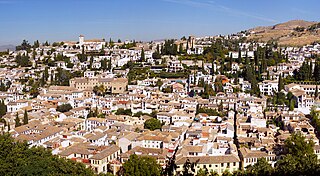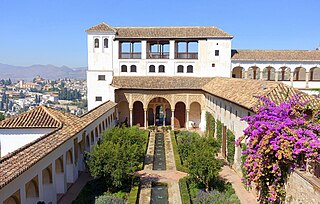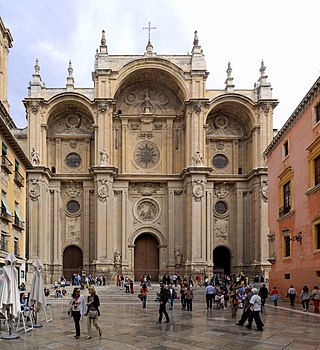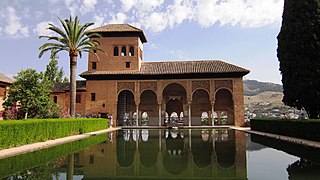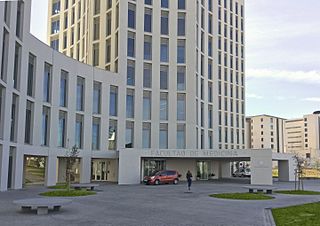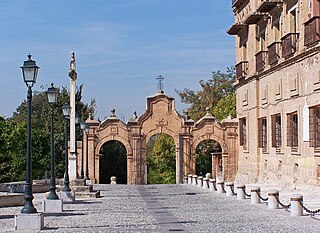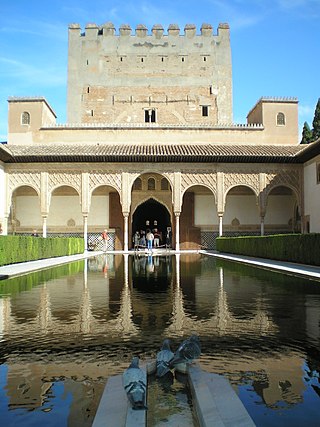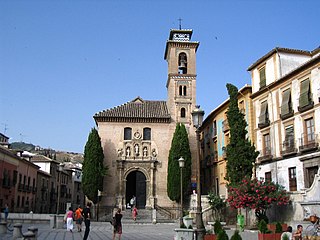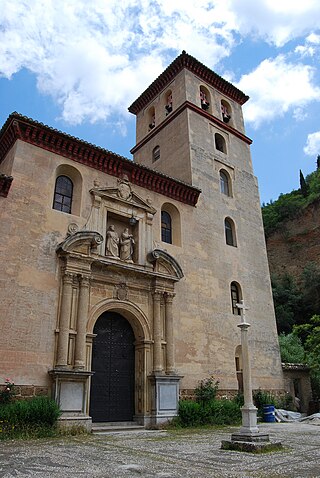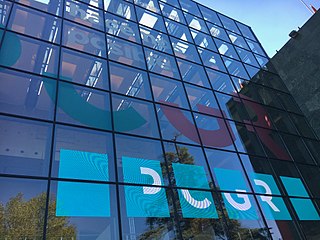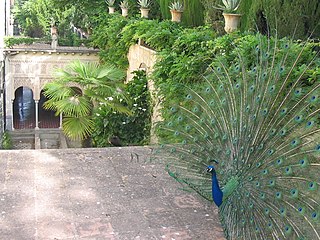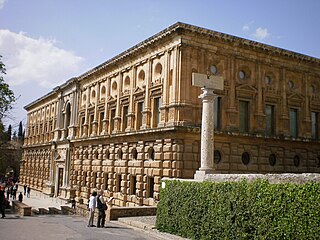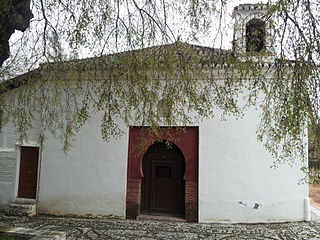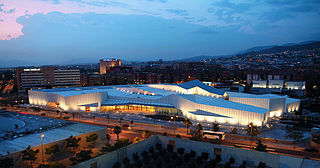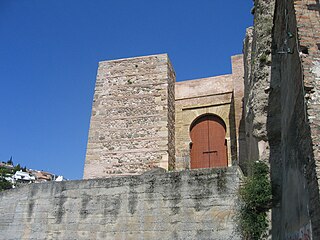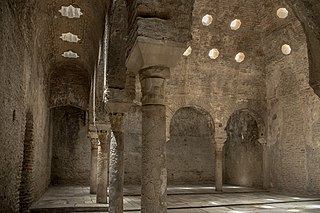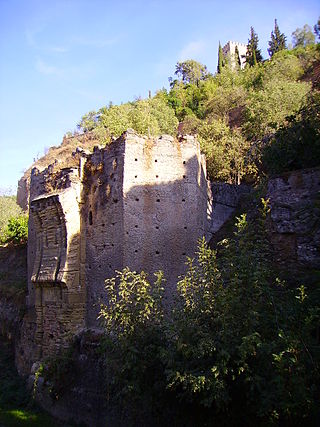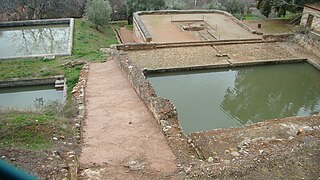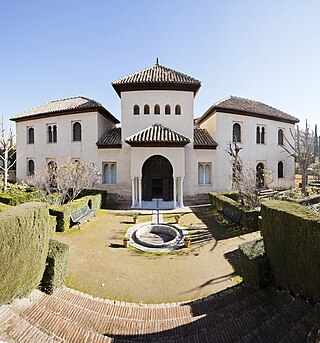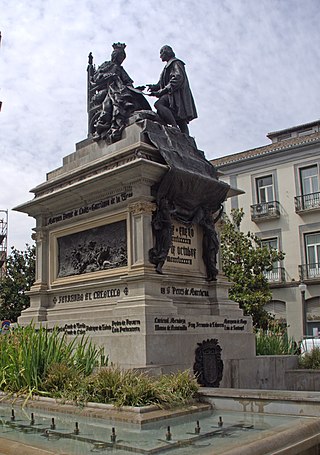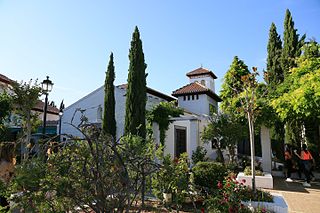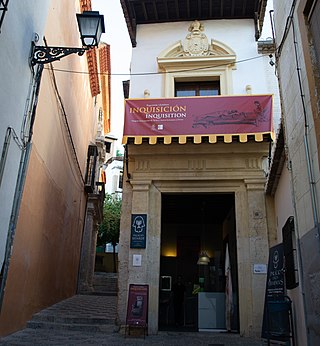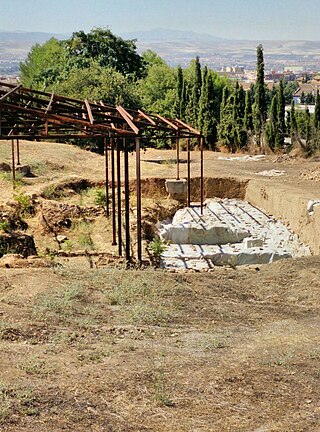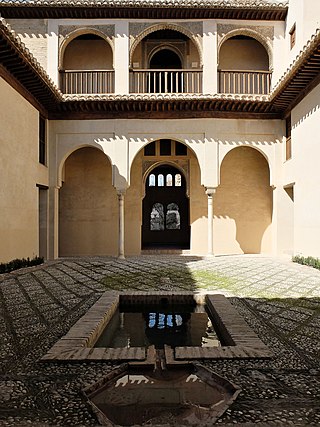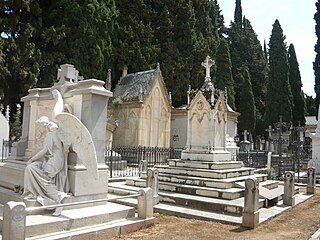34 Sights in Granada, Spain (with Map and Images)
Legend
Premium Sights
Book tickets, guided tours and activities in Granada.
Guided Free Walking Tours
Book free guided walking tours in Granada.
Welcome to your journey through the most beautiful sights in Granada, Spain! Whether you want to discover the city's historical treasures or experience its modern highlights, you'll find everything your heart desires here. Be inspired by our selection and plan your unforgettable adventure in Granada. Dive into the diversity of this fascinating city and discover everything it has to offer.
Sightseeing Tours in GranadaActivities in GranadaThe Albaicín, also spelled Albayzín, is a neighbourhood of Granada, Spain. It is centered around a hill on the north side of the Darro River which passes through the city. The neighbourhood is notable for its historic monuments and for largely retaining its medieval street plan dating back to the Nasrid period, although it nonetheless went through many physical and demographic changes after the end of the Reconquista in 1492. It was declared a World Heritage Site in 1994, as an extension of the historic site of the nearby Alhambra.
The Alhambra is a palace and fortress complex located in Granada, Spain. It is one of the most famous monuments of Islamic architecture and one of the best-preserved palaces of the historic Islamic world, in addition to containing notable examples of Spanish Renaissance architecture.
The Generalife was a summer palace and country estate of the Nasrid rulers of the Emirate of Granada in Al-Andalus. It is located directly east of and uphill from the Alhambra palace complex in Granada, Spain.
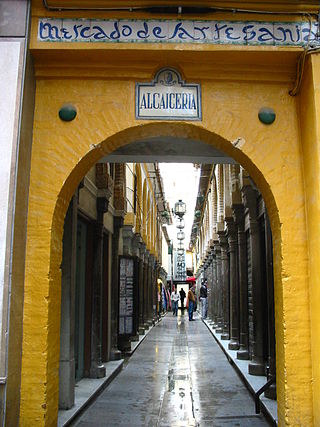
The Alcaicería de Granada is an alcaicería located in the vicinity of the Cathedral of Granada in Granada, Spain. Today, it is dedicated to Granada's craft shops, where the popular Fajalauza earthenware, wood inlay or inlay, and coloured glass lampposts are sold. It also includes shops such as bookshops, jewellery shops and hospitality establishments.
The Royal Chapel of Granada is an Isabelline style building in Granada, Spain. Constructed between 1505 and 1517, it was originally integrated in the complex of the neighbouring Granada Cathedral. It is the burial place of the Spanish monarchs, Queen Isabella I and King Ferdinand, the Catholic Monarchs. Apart from these historical links, this building also contains a gallery of artworks and other items associated with Queen Isabella.
The Metropolitan Cathedral-Basilica of the Incarnation, is a Roman Catholic cathedral in the city of Granada, Spain. The cathedral is the seat of the Archdiocese of Granada. Like many other cathedrals in Andalusia, it was built on top of the city's main mosque after the reconquest of Granada.
The Gate of the Pomegranates is an historical access point of a pathway that leads through the Forest of the Alhambra to the Nasrid palace that is the Alhambra, located in the city of Granada, Spain. The path starts in the city centre, Plaza Nueva, and continues up the Cuesta de Gomérez, before reaching the monument.
Partal Palace is a palatial structure inside the Alhambra fortress complex located in Granada, Spain. It was originally built in the early 14th century by the Nasrid ruler Muhammad III, making it the oldest surviving palatial structure in the Alhambra.
9. Facultad de Medicina
The Faculty of Medicine of Granada is a university teaching centre belonging to the University of Granada, where studies leading to the official title of doctor are taught, as well as others related to health sciences in general and medicine in particular.
Wikipedia: Facultad de Medicina de la Universidad de Granada (ES), Website, Heritage Website
10. Casa de los Tiros
The Casa de los Tiros is a museum and property located in the Spanish city of Granada, autonomous community of Andalusia. It is located in the Realejo neighborhood, on Pavaneras Street. Its name is due to the artillery pieces on its battlements. It is currently the headquarters of the Casa de los Tiros Museum in Granada; for some years, it was also the headquarters of the Ateneo de Granada.
11. Abadía del Sacromonte
The Sacromonte Abbey is an old abbey, from the seventeenth century, formerly a seminary, and a school with a student residence, today a canons' residence, parish and ecclesiastical museum, located in the northeast of the Spanish city of Granada, which is well accessed by the Sacromonte road, which begins at the Peso de la Harina located in the middle of the Cuesta del Chapiz, or along the old road of the Fargue starting from Haza Grande.
12. Palacios Nazaríes
The Nasrid palaces, also called the Royal Viejo Fourth are a palatine set of the Alhambra de Granada formed by two independent palaces, the Palace of Comares and the Palace of Los Leones, and annexes, Mexuar, chosen by the Catholic Monarchs to inhabit them in their stays In Granada of the end of palaces, palacetes, large house and towers-palacios that the palatine city of the Alhambra has housed. These residences were replaced according to the Islamic precepts of not building anything that is perpetuated in time and the tradition that each Sultan made their palace to demonstrate their personal power. The decision of the Catholic Monarchs guaranteed their conservation, compared to other abused Arab monuments, abandoned or destroyed, mostly by the Napoleonic troops in their attempt to destroy the citadel to their flight. Some of these palaces were hosting the Nazarí Court, performing administrative functions, protocol, residential and enjoyment. Chronologically they were raised after the Alcazaba, the Generalife and the partal, being its construction of the first third of the fourteenth century.
13. Court of the Myrtles
The Court of the Myrtles is the central part of the Comares Palace inside the Alhambra palace complex in Granada, Spain. It is located east of the Mexuar and west of the Palace of the Lions. It was begun by the Nasrid sultan Isma'il I in the early 14th century and significantly modified by his successors Yusuf I and Muhammad V later in the same century. In addition to the Court of the Myrtles, the palace's most important element is Hall of Ambassadors, the sultan's throne hall and one of the most impressive chambers in the Alhambra.
14. Iglesia de San Gil y Santa Ana
The church of Santa Ana, officially the parish church of San Gil y Santa Ana is a parish church of the Roman Catholic Church in Granada, autonomous community of Andalusia, Spain. It is part of the group of Mudejar churches in the city; it is located on the left bank of the Darro River, in a small square annexed to the space dominated by the Plaza Nueva, at the beginning of the Carrera del Darro and at the foot of the Alhambra, near the Royal Chancery and the Pilar del Toro fountain.
15. Iglesia de San Pedro y San Pablo
The church of San Pedro and San Pablo in the Spanish city of Granada, autonomous community of Andalusia, is of Mudejar and Renaissance styles, designed by the architect Juan de Maeda, it was built in the sixteenth century, between the years 1559 and completed in 1567.
16. Palacio de Congresos de Granada
The Palacio de Exposiciones y Congresos de Granada is a convention building located in the Andalusian city of Granada (Spain), whose main function is to hold congresses and trade fair exhibitions, as well as concerts and shows. It is located in the centre of the city, on the Paseo del Violón, next to the left bank of the Genil River.
17. Carmen de los Mártires
The Carmen de los Mártires is a famous carmen and garden located in the Spanish city of Granada. It is located on the southern slope of the hill of the Mauror hill that supports the Torres Bermejas at its top, within the enclosure of the Alhambra, in the lands known until the fourteenth century by the Arabs as Campo de Ahabul and by the Christians as the Campo or corral de los Cautivos. With its more than seven hectares, it is the largest of the city's cármenes, which includes a magnificent palace, romantic gardens and Nasrid orchards over the capital of Granada, with extraordinary panoramic views of the Sierra Nevada, the Vega and the city.
18. Museo de la Alhambra
The Alhambra Museum is located in the city of Granada, located in the south wing of the ground floor of the palace of Charles V in the Alhambra. It houses objects, belongings, books and architectural remains of Hispano-Muslim art dating from the middle of the eighth century to the last years of the Nasrid culture, the result of excavations carried out in the city of Granada itself and donations from other points. It consists of seven rooms where the objects are distributed thematically and chronologically.
19. Ermita de San Sebastián
The hermitage of San Sebastián and San Fabián was originally a construction half military fortress and half religious that the Muslims built on the border with the Christian kingdoms, dating from the thirteenth century. Built in 1218, under Almohad domination, it belongs to the route of the caliphate. It is located in the Spanish city of Granada, autonomous community of Andalusia, at the end of the Paseo del Violón, on the left bank of the Genil River.
20. Parque de las Ciencias
Parque de las Ciencias is a science center and museum located in the city of Granada, Spain. It is a member of the European Network of Science Centers and Museums (ECSITE). The facility encompasses 70,000 square meters and offers a variety of experiences. These include permanent and temporary exhibits, a planetarium, educational spaces, and amenities like a cafe, restaurant, bookstore, library, and cinemas. Additionally, the Parque de las Ciencias has unique features such as a plastination lab and restoration and production workshops.
21. Centro Federico García Lorca
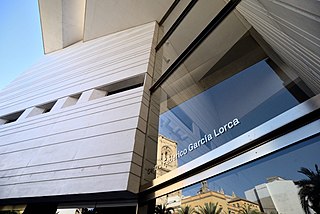
The Federico García Lorca Centre is a cultural institution aimed at the study and research of the life and work of the poet Federico García Lorca (1898-1936), as well as the dissemination of his literary production and the conservation of his documentary legacy. In addition, it is a space designed to house all kinds of contemporary artistic manifestations, preferably those related to the author. It is managed by a consortium made up of the Ministry of Culture of the Government of Spain, the Ministry of Culture of the Junta de Andalucía, the City Council of Granada and the Provincial Council of Granada. Its headquarters are located in the Plaza de la Romanilla in Granada, in the heart of the historic center of the city.
22. Monaita Gate
The Monaita gate, in Arabic bab al-Unaydar, whose translation would be Puerta de la Erilla, also known as Puerta de la Alhacaba, was one of the oldest accesses in Granada, and the main one to the Qadīma citadel or Antigua citadel, in the Albaicín neighborhood.
23. El Bañuelo
The Bañuelo or El Bañuelo, also known as the Baño del Nogal or Hammam al-Yawza, is a preserved historic hammam in Granada, Spain. It is located in the Albaicin quarter of the city, on the banks of the Darro River. It was used as a bathhouse up until the 16th century at least, before becoming defunct and being converted to other uses. In the 20th century it underwent numerous restorations by Spanish experts and is now open as a tourist attraction.
24. Puente del Cadí
The Cadí bridge is located in the urban area of Granada, over the Darro River. Currently only one of its two abutments are still standing, specifically the one located on the edge of the Alhambra Forest, in the shape of a hexagonal tower, as well as the start of a large horseshoe vault.
25. Parque Federico García Lorca
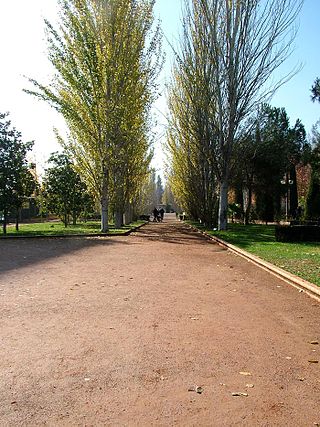
The Park Federico García Lorca is a park situated in Arabial St., Granada, Spain. It is named after the Spanish poet Federico García Lorca. It is designed with avenues and palm trees. The park is opened to the public during daylight hours. Admission is free.
26. Los Albercones
Los Albercones is the name given to a hydraulic complex from the Nasrid period, located in the Generalife, within the Alhambra enclosure, in Granada. Together with the Acequia Real and the Pozos Altos, it forms one of the most important medieval hydraulic systems in Spain.
27. Alcázar Genil
The Alcázar Genil is a Muslim-era palace in the city of Granada, Spain. It was originally called al-Qasr al-Sayyid and is located beside the River Genil outside the city walls. Today, only a pavilion of the palace is preserved. It currently houses the Francisco Ayala Foundation.
28. Aljibe del Rey
The Aljibe del Rey in the Albaicín district in Granada, Spain is a cistern dating from the 10/11th centuries. Built by the Nasrid rulers to provide water to their palace complex, al-Qaṣaba al-Qadīma, it is the largest cistern in the district. The aljibe is now managed by the AguaGranada Foundation and the attached carmen (house) contains an interpretation centre. The aljibe is open daily.
29. Monumento a Isabel la Católica
The Monument to Isabella the Catholic also known as the Monumento a Isabel la Católica y Colón or monumento del IV Centenario is an instance of public art in Granada, Spain. Designed by Mariano Benlliure, it consists of a bronze sculptural group depicting a meeting of Isabella I of Castile with Christopher Columbus.
30. Mezquita de Granada
The Granada Mosque is located adjacent to the Plaza San Nicholas in the Albaicin district of Granada, Spain. It was the first mosque built in the city since 1492, when the conquest of Granada by Queen Isabella I of Castile and King Ferdinand II of Aragon concluded the reconquest of Spain by the Catholic Monarchs. Funded mainly by overseas donations, and local support, the mosque was opened in 2003.
31. Palacio de los Olvidados
The Palace of the Forgotten is a museum in Granada, Spain, dedicated to the Spanish Inquisition, Jewish history, and Granada's and Andalusia's heritage. The building is located in the Albaicín, a neighbourhood declared a World Heritage Site by UNESCO in 1994 as an extension of the monumental complex of the Alhambra and the Generalife.
Wikipedia: Palacio de los Olvidados (EN), Website, Facebook, Instagram
32. Alfar Romano de Cartuja
The Alfar Romano de Cartuja is a pottery site located between the current Faculty of Theology and the Faculty of Education Sciences of the Cartuja University Campus, in Granada, Spain. It occupies an area of more than three hectares of which only a part has been excavated.
33. Palacio de Dar al-Horra
Dar al-Horra is a former 15th-century Nasrid palace located in the Albaicín quarter of Granada, Spain. Since the early 16th century it was used as part of the Monastery of Santa Isabel la Real. It is now a historic monument.
34. Cementerio de San José
The cemetery of San José is a Spanish cemetery located in the city of Granada, Spain. It is located in the Generalife pasture, to the east of the city, in the monumental surroundings of the Alhambra. It occupies about 110,000 square meters distributed in 19 courtyards. It dates back to the nineteenth century.
Wikipedia: Cementerio de San José de Granada (ES), Heritage Website
Share
How likely are you to recommend us?
Disclaimer Please be aware of your surroundings and do not enter private property. We are not liable for any damages that occur during the tours.
